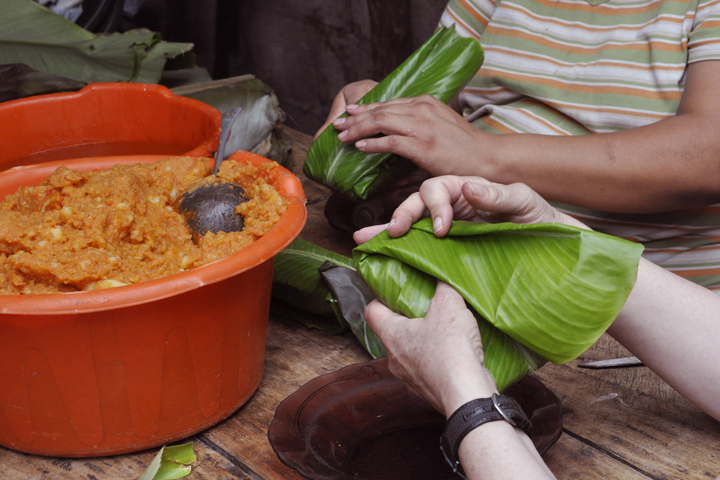On Feminism, Food, Fun, and Scholarship
David Salmanson, Springside Chestnut Hill Academy
Philadelphia, Pennsylvania
First, a bit of background. I signed up for the panel, in part, because two women I admire very much, Dr. Mary E. Mendoza, a friend, and Dr. Maria Montoya, a mentor and friend (and a member of my dissertation committee) were two of the four organizers. The other two were Dr. Lori Flores and Dr. Rachel St. John.** I’ve also read Que Vivan Los Tamales by Jeffery Pilcher about the history of tamales in Mexico. The book has stayed with me, especially the chapters about battles over corn vs. flour tortillas and the chapter on the introduction of commercial masa. The first chapter was about how what turned out to be bad nutrition science was used to denigrate corn (perceived as indigenous, brown, bad) and promote flour (white, European, good). The other chapter was about how women’s embrace of commercial masa freed them from tedious masa making and allowed them to either pursue wage work or leisure time. This also led to a backlash by men, particularly elite men, who feared the consequences of either of these options. Plus, I’ve worked as a cook and I’m always looking for new tools for my cooking toolbox. I’ve never made tamales and I wanted to know how it was done. So you factor these three things: friendship, intellectual curiosity, and opportunities to learn technique and this was the first session I signed up for.
The four scholars walked us through the tamale making process, each while providing a section on the history of the tamale and their own relationships with tamales. As audience members, we made our own tamales with supplies that were on the round tables we sat at.

Lesson: how to make tamales San Antonio Aguas Calientes, Guatemala. SanAntoniotamalesGH7751
Tamales are intensely labor intensive. Making the masa and the filling can take days. Even though using commercial masa is a timesaver, it’s still a laborious process. So really, this panel on tamale making was just the last step. And even though the ingredients were pre-made for us by teams of Mendoza women over the last several days (more on that in a moment), my first tamale took me over 20 minutes to make. This included coating the pre-soaked corn husks with masa, inserting the filling, wrapping the tamale, and tying it up.
The tamales were placed in instapots to be cooked and then we had a catered lunch (including fantastic tamales from a local supplier).
So you can see why this was a popular session, but there was incredible intellectual depth to it. I wasn’t able to take notes as I went along (my gloved hands being covered in masa) but I wanted to note some important points.
1. There isn’t a single tamale making tradition. This was especially evident when it came to questions over tying vs. not tying tamales.
2. The story-telling part was extremely important to the session. As each of our scholar-hosts told us about tamale history, she also located herself within that history. Family histories and social networks were revealed. Mary Mendoza’s stories mostly revolved her extended kinship network, still very much in San Antonio and present at the session to help out. Maria Montoya talked about creating new networks of tamale making as a way of creating community in places far distant from her childhood home.
3. Support, support. support! As the various tamale making experts on hand circulated around the room, they were amazingly supportive of the many novices, even as they provided gentle instruction and correction.
4. Credit was generously shared. It took a lot of people to do the prep work for this, and they were expressly and repeatedly named, acknowledged, and applauded. Part of the point of the session was to make the gendered work behind tamale making visible.
5. Food history and family history are both pretty important fields. The intersection of the two leads to powerful scholarship (not just at this panel but see, fore example, Michael Twitty’s The Cooking Gene).
6. We need another term than cultural appropriation. The session ended with Maria Montoya, who is an administrator at NYU Shanghai telling a story about a Chinese woman who dated a Mexican and learned to make tamales. She ditched the guy but kept the recipes and runs a booming tamale making business in Shanghai. One of her top clients is Dr. Montoya.
7. This whole session was a metaphor for feminist scholarship. It also was feminist scholarship.
8. We didn’t get to do the usual post-panel Q and A. I’ll leave my question here. We heard a lot about family fights over tamale making. Are fights over food proxies for other fights, or are they what they appear?
So that’s that. I think. I’m really tired so I’m probably forgetting stuff. But not as tired as the people who put in all the work before I ever set foot in the room where the panel took place.
Oh and postscript. The ratio of men to women who attended the panel was around 1:9.
Postscript 2. Which is to say all of this is a metaphor for what happens in the academy But especially for women professor’s careers. Lots of unseen labor. Lots of care for others beyond the immediate job description and then other people get the bulk of the yummy stuff.
Post slightly modified to clarify the metaphor in Postscript 2
*Special thanks to Miriam Salmanson, Jon Salmanson, Michael Salmanson and Tobi Zemsky who cared for my children in various capacities while I was gone and various parents of my kids classmates who drove them places. This made my trip possible. Also making this trip possible was generous financial support from SCH Academy.
**Normally, when we talk scholarship around here, we don’t use the Dr. titles, but I’m using them here to emphasize that each of these women is a respected, dynamic, expert in her field.
